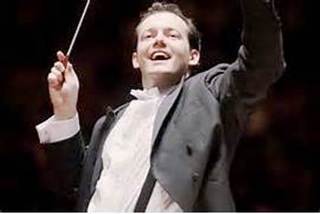|
Back
Numinous Heavens, Primitive Earth New York
Isaac Stern Auditorium, Carnegie Hall
02/28/2017 - & February 23, 24, 25, 2017 (Boston)
Sofia Gubaidulina: Triple Concerto for Violin, Cello, and Bayan
Dmitri Shostakovich: Symphony No. 7 (“Leningrad”), op. 60
Baiba Skride (Violin), Harriet Krijgh (Cellist), Elsbeth Moser (Bayan)
Boston Symphony Orchestra, Andris Nelsons (Conductor)

A. Nelsons
“It saddens me that people don’t always understand what the “Leningrad Symphony” is about. Yet everything is clear in the music.”
Dmitri Shostakovich, as quoted in Testimony by Solomon Volkov
The quote from Solomon Volkov’s alleged “autobiography” is just as paradoxical as the composer’s whole inner life. For absolutely nothing is clear about Shostakovich’s intentions in his 75-minute-long Seventh Symphony.
More than 70 years after its first performance in a newly freed Leningrad–and one year after Brian Moynahan’s agonizing, tragic book Leningrad: Siege and Symphony–we still don’t know if it’s about the German siege of the town, or Stalin’s torture of his own people, or Shostakovich’s own inner questions.
Or whether (most unlikely) the Leningrad Symphony was pure music without any outer significance.
What we did know last night that the Boston Symphony Orchestra offered a thrilling, dynamic orchestral palette. And if the inner movements never quite overcame the composer’s longueurs and frequent saunterings through tangled musical woods, conductor Andris Nelsons kept this splendid orchestra on its pace.
But one would expect nothing less with the Boston Sympbony Orchestra. Ever since 1924, when Serge Koussevitzky became their musical director, the BSO has heralded both Russian music and futuristic music. And the ensemble produced both last night.

D. Shostakovich/S. Gubaidulina (© npr.org/remusik.org)
Sofia Gubaidulina was in the audience for the New York premiere of her Triple Concerto, and the applause was well-deserved. The composer frequently uses the Russian accordion, the bayan, but paired (or tripled) with the violin and cello, the sounds were new, disturbing (in a good way) and offered an atmosphere which was piercing, haunting and sometimes shimmering with almost heavenly brightness.
Ms. Gubaidulina herself had described the Triple Concerto as a kind of paean to the mystical Holy Trinity, yet one didn’t have to know that. Any more than one has to know about another mystical three, the Rosicrucian significant in Mozart’s Magic Flute. Instead, one was immediately placed in a kind of numinous aura, with the bayan playing an impenetrable chord. Whatever the composer meant, this one chord, repeated several times, like a shot of the universe, all the heavenly objects in one black hole. And gradually floating apart like a time-space element, allowing us to examine each object in turn.
The single motifs (outside of a return to that infinite chord) were the responses to the solo and orchestral work by the lowest instruments in the orchestra. Double-basses, contrabass tuba (is there such an instrument?), tuba, trombones and bassoons joined in response to the more interesting music played by the soloists.
And while the first section lulled us into the aura of the music, the second section was heavenly. Cello, violin and bayan at their highest registers, playiing mini-cadenzas, shining, glowing, preparing us for more black holes in the finale. Bayan and bass instruments yet with the French horn at its highest notes, preparing us for the end.
One might not have grasped the entire half-hour work at one sitting, but enough material was presented to offer a longing for more performances.
After the intermission, conductor Nelsons gave a driving energetic performance of the Leningrad. If this is program music, one can take the opening as a picture of verdant Leningrad, as tranquil as a Grieg landscape, before the Germans invade.
And here, in these eleven repetitions, Maestro Nelsons gave a variegated, picture of an almost unstoppable force. (No reason to go further on this: Mr. Moynahan’s book gives all the suffering which the Russians felt.)
The second and third movements wandered along erratically. I don’t say this critically, since the composer had his own pictures to give. And when those peerless BSO violins played their frequent solos, one understand how a great orchestra performs. Mr. Nelsons, needless to say, took us by the aural hands through the labyrinthine gallery of thoughts.
For the end, Stalin apparently wanted an 1812 Overture kind of finale. But this was not the Crimean War. This was a battle symphony of the most primitive and unending brutality. And if Shostakovich’s message was amorphous and ambiguous, the last measures gave a frantic, almost frenetic picture of triumph and tragedy.
If we still don’t know whose triumph and tragedy, that, in the long run is immaterial. The music gave its own message loud (very loud) and clear.
Harry Rolnick
|